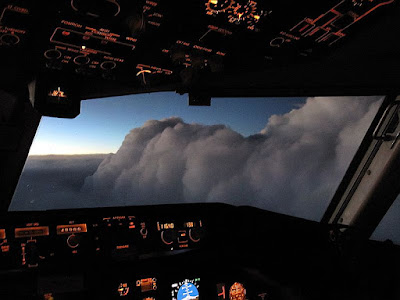Our usual day to day domestic operations are pretty much routine in that we fly from point A to point B, ATC communications are always available, we enjoy radar coverage the entire way, we can expect a full ILS approach at our destination to be available in case it is necessary, and generally the entire leg is pretty easy.
Even most of our international flying is pretty much routine nowadays. Gone are the days of VOR and ADF navigation. Even VLF and Omega type navs are gone. For the most part, the airline world has transitioned to GPS navigation. Sure there are some air carriers that are still operating with older equipment, but the vast majority are using some form of advanced navigation.
Our older 767's and 757's are still using Inertial Reference Systems but the newer ones have been outfitted with satellite based GPS type navs. Both are more than capable.
Then every once in a while we get to fly into a destination that is a real eye opener and we can really appreciate having those advanced navigation systems on board with us.
A two hour late start from Miami meant we would be arriving at PAP just after sunset. The forecast was calling for good weather and winds favoring runway 10 which has an ILS approach. Good!
The climb up to FL 370 was uneventful. 600 miles later and approaching Haitian airspace, we said "goodbye" to Miami Center and gave Port Au Prince Control a call.
No response.
While descending, we passed an opposite direction outbound airliner 1000 ft below us and wondered why we weren't advised? A call to Approach Control about that went unanswered.
Without radar coverage we would have to make position reports the entire way in to PAP. The charted approach requires us to fly a DME ARC to intercept the ILS to runway 10. No problem today, we had GPS capability and the "box" tracked it perfectly. Several position reports later we were tracking the ILS inbound as Approach Control handed us off to PAP Tower.
Then Tower advised us that the winds had shifted and to fly the ILS runway 10 approach and circle to land on runway 28. Good thing we had briefed this possibility and were prepared.
"Cleared to land on runway 28, caution for Cessna traffic in the pattern" came the call from Tower in a French Creole accent.
The sun had already set and the high terrain was obscured with smoke and haze. We spotted the runway at about 3 miles out and commenced the circling approach. The FO was flying and flew a right downwind as a left downwind is not permitted due to terrain issues. Keeping the runway in sight was paramount since there was no approach available for runway 28. He did a fine job and greased the 767 in the touchdown zone and we were stopped with room to spare. 
PAP has no parallel taxiways and the runaway is too narrow for an airliner to do a U-turn on so we had to taxi to the end where there is a turn around area for bigger planes. Meanwhile, the runway was closed for any other traffic while we were taxiing. So every time an airliner or any other plane is on the runway, the airport is essentially closed to all other traffic until the runway is cleared. This can lead to some lengthy delays.



No layover here, just a quick refueling and we launched back to Miami and enjoyed smooth skies at 40,000 ft.
For a look at some more of my photos, please aviate over to Plane & Simple.
Friday, December 4, 2009
Third World Operations
Labels: airline pilot, Boeing 767, Port Au Prince Haiti
Subscribe to:
Post Comments (Atom)





10 comments:
Did you get a new camera? Your pics looks fantastic!
Great post, really enjoyed it--thank you. The things you guys see...amazing. Big fan of your blog--keep up the great work.
Hi Lee,
Thanks! No new camera. I usually just carry a cheapo Canon point & shoot. Occasionally I carry a Nikon DSLR when I think there might be something interesting to photograph.
The Haiti shots were with the cheapo Canon.
Len
Great read Len! We always take for granted that there are all the up to date aids are always available. I remember 14 or so years ago when I was lucky to sit in the cockpit down the length of Africa, there was no ATC let alone radar, so all aircraft made VHF calls every 30 minutes. Today, 14 years later, according to a friend that flies for South African, it is still the same in certain parts of Africa! Amazing in this century where we are soon to do things like buy tickets to space!
Hi Mark,
Thanks!
Do you already have your ticket reserved with Virgin Galactic? Hah.
That will be a fun trip someday.
Len
LOL..I wish!!! It's going to be a heck of a trip - and I see that Spaceship 2 is out now - just on the front page of MSNBC.com!
Great Pics Len!
It is definitely strange to see that many non-reflective-vest-wearing types wandering around on the tarmac!
I'm guessing it was just their carry-ons, but it looks like you made them go in the pit and get their bags too! haha
I've always wondered how it was flying in other than first world countries. We do take what the US has done for aviation for granted.
Thanks for that, Len.
Since the earthquake we've heard a lot about that airport. Your description puts it all in context.
A well written post.. I have a friend in Kansas that works for the airlines and TSA as well.. double duty... I've heard her' horror' stories as well. Love the last photo!.
Post a Comment